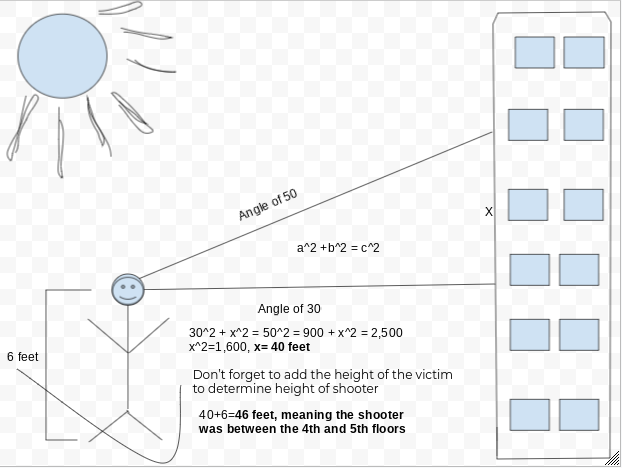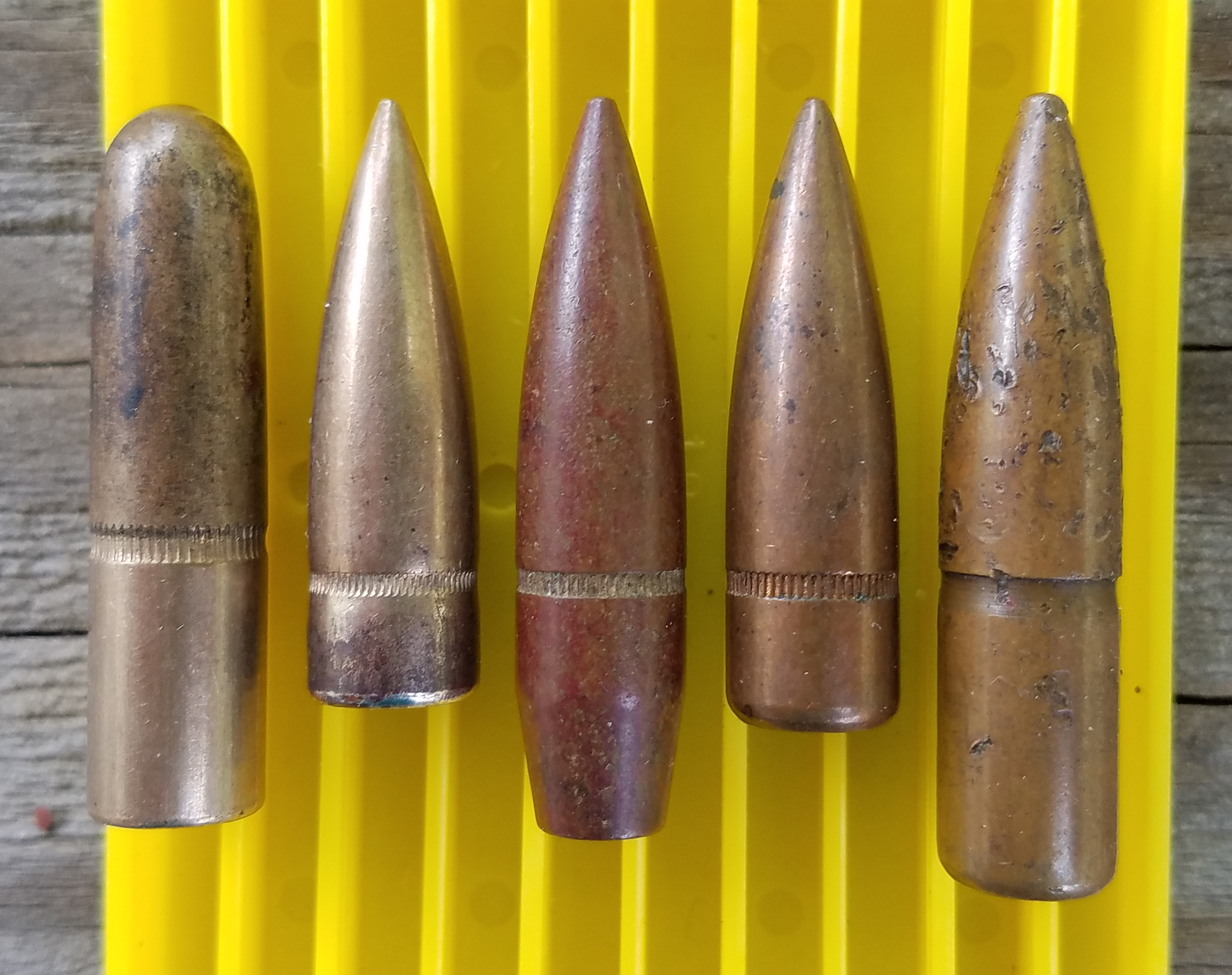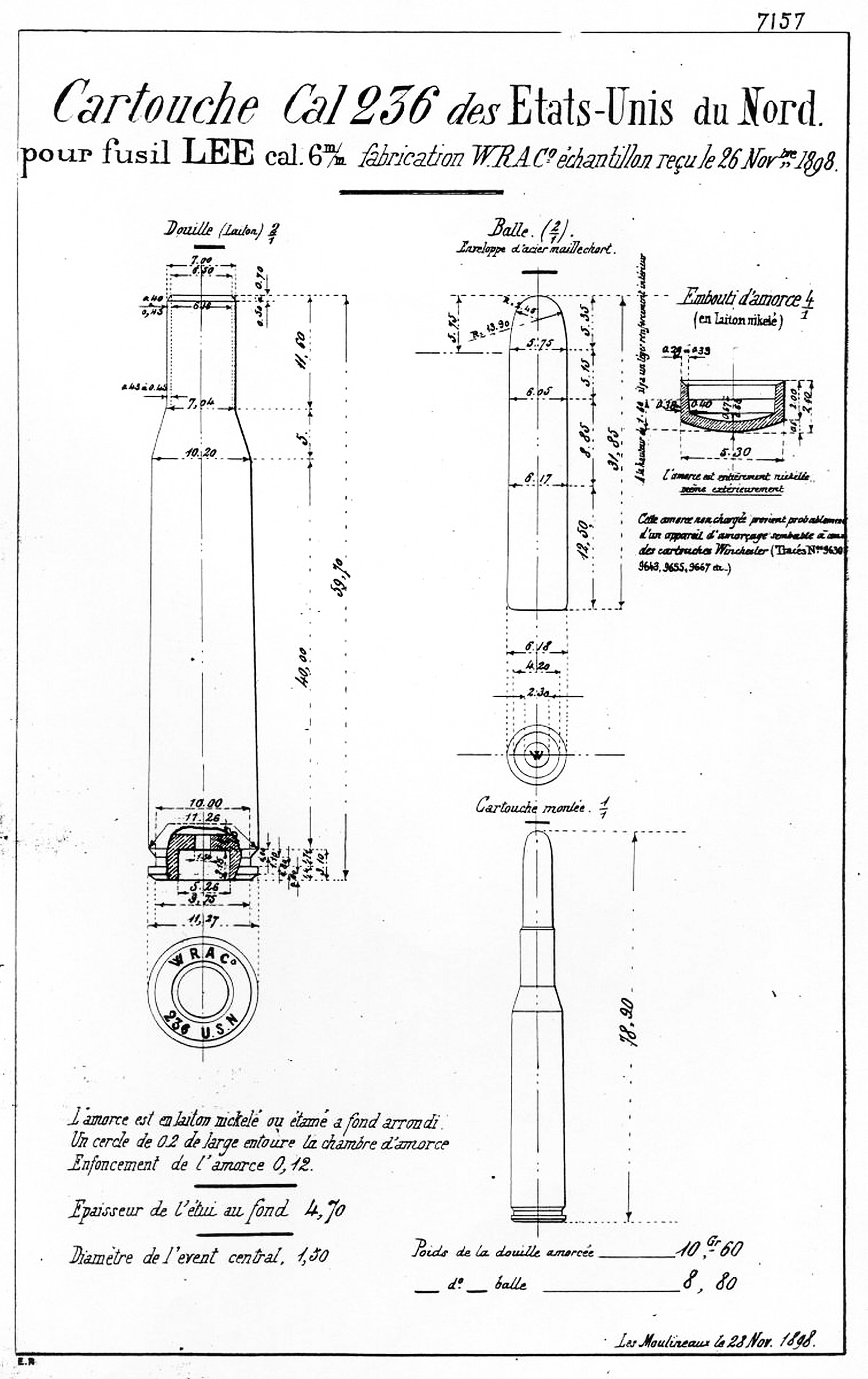|
.30-06
The .30-06 Springfield cartridge (pronounced "thirty- aught-six" ), 7.62×63mm in metric notation, and called the .30 Gov't '06 by Winchester, was introduced to the United States Army in 1906 and later standardized; it remained in military use until the late 1970s. The ".30" refers to the caliber of the bullet in inches. The "06" refers to the year the cartridge was adopted, 1906. It replaced the .30-03, 6mm Lee Navy, and .30-40 Krag cartridges. The .30-06 remained the U.S. Army's primary rifle and machine gun cartridge for nearly 50 years before being replaced by the 7.62×51mm NATO and 5.56×45mm NATO, both of which remain in current U.S. and NATO service. It remains a very popular sporting round, with ammunition produced by all major manufacturers. History In the early-1890s, the U.S. military adopted the smokeless powder .30-40 Krag rimmed cartridge. The 1894 version of that cartridge used a round-nose bullet. Around 1901, the U.S. started developing an experimen ... [...More Info...] [...Related Items...] OR: [Wikipedia] [Google] [Baidu] |
30-03
The .30-03 Springfield (7.62×65mm) was a short-lived cartridge developed by the United States in 1903, to replace the .30-40 Krag in the new Springfield 1903 rifle. The .30-03 was also called the .30-45, since it used a 45 grain () powder charge; the name was changed to .30-03 to indicate the year of adoption.''Cartridges of the World'' (11th Edition), Frank C. Barnes, Edited by Stan Skinner, Gun Digest Books, 2006, pp.130,164 It used a 220 grain () roundnose bullet. It was replaced after only three years of service by the .30-06, firing a spitzer bullet giving better ballistic performance. Initial development The .30-03 was developed to replace the .30-40 Krag cartridge used in the Krag–Jørgensen rifle, which was the first bolt action rifle adopted by the US military, and the first that used smokeless powder. The Krag–Jørgensen rifle had some serious limitations compared to the new Mauser rifles being used by European armies; it was loaded one round at a time, ra ... [...More Info...] [...Related Items...] OR: [Wikipedia] [Google] [Baidu] |
M1903 Springfield
The M1903 Springfield, officially the United States Rifle, Caliber .30-06, Model 1903, is an American five-round magazine-fed, bolt-action service repeating rifle, used primarily during the first half of the 20th century. The M1903 was first used in combat during the Philippine–American War, and it was officially adopted by the United States as the standard infantry rifle on June 19, 1903, where it saw service in World War I, and was replaced by the faster-firing semi-automatic eight-round M1 Garand starting in 1936. However, the M1903 remained in service as a standard issue infantry rifle during World War II, since the U.S. entered the war without sufficient M1 rifles to arm all troops. It also remained in service as a sniper rifle during World War II, the Korean War, and the Vietnam War. It remains popular as a civilian firearm, historical collector's piece, a competitive shooting rifle, and as a military drill rifle. History Background During the 1898 war with Spain, ... [...More Info...] [...Related Items...] OR: [Wikipedia] [Google] [Baidu] |
M1903 Springfield Rifle
The M1903 Springfield, officially the United States Rifle, Caliber .30-06, Model 1903, is an American five-round magazine-fed, bolt-action service repeating rifle, used primarily during the first half of the 20th century. The M1903 was first used in combat during the Philippine–American War, and it was officially adopted by the United States as the standard infantry rifle on June 19, 1903, where it saw service in World War I, and was replaced by the faster-firing semi-automatic eight-round M1 Garand starting in 1936. However, the M1903 remained in service as a standard issue infantry rifle during World War II, since the U.S. entered the war without sufficient M1 rifles to arm all troops. It also remained in service as a sniper rifle during World War II, the Korean War, and the Vietnam War. It remains popular as a civilian firearm, historical collector's piece, a competitive shooting rifle, and as a military drill rifle. History Background During the 1898 war with Spain, th ... [...More Info...] [...Related Items...] OR: [Wikipedia] [Google] [Baidu] |
Cartridge (weaponry)
A cartridge or a round is a type of pre-assembled firearm ammunition packaging a projectile (bullet, shot, or slug), a propellant substance (usually either smokeless powder or black powder) and an ignition device ( primer) within a metallic, paper, or plastic case that is precisely made to fit within the barrel chamber of a breechloading gun, for the practical purpose of convenient transportation and handling during shooting. Although in popular usage the term "bullet" is often informally used to refer to a complete cartridge, it is correctly used only to refer to the projectile. Cartridges can be categorized by the type of their primers – a small charge of an impact- or electric-sensitive chemical mixture that is located: at the center of the case head (centerfire); inside the rim ( rimfire); inside the walls on the fold of the case base that is shaped like a cup (cupfire, now obsolete); in a sideways projection that is shaped like a pin ( pinfire, now obsolete); o ... [...More Info...] [...Related Items...] OR: [Wikipedia] [Google] [Baidu] |
Improved Military Rifle
Improved military rifle propellants are tubular nitrocellulose propellants evolved from World War I through World War II for loading military and commercial ammunition and sold to civilians for reloading rifle ammunition for hunting and target shooting. These propellants were DuPont modifications of United States artillery propellants.Davis pp.296&297 DuPont miniaturized the large artillery grains to form military rifle propellants suitable for use in small arms. These were improved during the first world war to be more efficient in rimless military cartridges replacing earlier rimmed rifle cartridges. Four-digit numbers identified experimental propellants, and a few successful varieties warranted extensive production by several manufacturers. Some were used almost exclusively for military contracts, or commercial ammunition production, but a few have been distributed for civilian use in handloading. Improved military rifle propellants are coated with dinitrotoluene (DNT) to slow i ... [...More Info...] [...Related Items...] OR: [Wikipedia] [Google] [Baidu] |
Caliber
In guns, particularly firearms, caliber (or calibre; sometimes abbreviated as "cal") is the specified nominal internal diameter of the gun barrel bore – regardless of how or where the bore is measured and whether the finished bore matches that specification. It is measured in inches or in millimeters. In the United States it is expressed in hundredths of an inch; in the United Kingdom in thousandths; and elsewhere in millimeters. For example, a "45 caliber" firearm has a barrel diameter of roughly . Barrel diameters can also be expressed using metric dimensions. For example, a "9 mm pistol" has a barrel diameter of about 9 millimeters. Since metric and US customary units do not convert evenly at this scale, metric conversions of caliber measured in decimal inches are typically approximations of the precise specifications in non-metric units, and vice versa. In a rifled barrel, the distance is measured between opposing lands or between opposing grooves; groove mea ... [...More Info...] [...Related Items...] OR: [Wikipedia] [Google] [Baidu] |
303 British
The .303 British (designated as the 303 British by the C.I.P. and SAAMI) or 7.7×56mmR, is a calibre rimmed rifle cartridge. The .303 inch bore diameter is measured between rifling lands as is the common practice in Europe which follows the traditional black powder convention. It was first manufactured in Britain as a stop-gap black powder round put into service in December 1888 for the Lee–Metford rifle. From 1891 the cartridge used smokeless powder which had been the intention from the outset, but the decision on which smokeless powder to adopt had been delayed. It was the standard British and Commonwealth military cartridge for rifles and machine guns from 1889 until the 1950s when it was replaced by the 7.62×51mm NATO. Cartridge specifications The .303 British has 3.64 ml (56 grains H2O) cartridge case capacity. The pronounced tapering exterior shape of the case was designed to promote reliable case feeding and extraction in bolt-action rifles and machine guns a ... [...More Info...] [...Related Items...] OR: [Wikipedia] [Google] [Baidu] |
Boat-tail Bullet
External ballistics or exterior ballistics is the part of ballistics that deals with the behavior of a projectile in flight. The projectile may be powered or un-powered, guided or unguided, spin or fin stabilized, flying through an atmosphere or in the vacuum of space, but most certainly flying under the influence of a gravitational field. Gun-launched projectiles may be unpowered, deriving all their velocity from the propellant's ignition until the projectile exits the gun barrel. However, exterior ballistics analysis also deals with the trajectories of rocket-assisted gun-launched projectiles and gun-launched rockets; and rockets that acquire all their trajectory velocity from the interior ballistics of their on-board propulsion system, either a rocket motor or air-breathing engine, both during their boost phase and after motor burnout. External ballistics is also concerned with the free-flight of other projectiles, such as balls, arrows etc. Forces acting on the projectile W ... [...More Info...] [...Related Items...] OR: [Wikipedia] [Google] [Baidu] |
Spitzer (bullet)
The spitzer bullet (or spire point) is a pointed projectile that is primarily used in small-arms. The pointed nose shape, which was developed for military purposes in the late 19th and early 20th century, was a major design improvement compared to earlier rounder or flatter-tipped bullets because pointed nose shapes were less susceptible to external ballistic factors like drag. By adding a point, projectiles made for fully-powered and intermediate rifle cartridges, obtain a lower drag coefficient which makes them decelerate less rapidly. Lowering the drag coefficient leads to improved external ballistic behaviour. The development of spitzer bullets and long-range volley sights for service rifles changed military doctrines. Area targets at ranges up to could be subject to rifle fire. With improvements in machine guns at the turn of the 20th Century, the addition of clinometers meant that fixed machine gun squads could deliver plunging fire or indirect fire at more than . ... [...More Info...] [...Related Items...] OR: [Wikipedia] [Google] [Baidu] |
30-40 Krag
The .30-40 Krag (also known as .30 U.S. and .30 Army) was a cartridge developed in the early 1890s to provide the U.S. armed forces with a smokeless powder cartridge suited for use with modern small-bore repeating rifles to be selected in the 1892 small arm trials. Since the cartridge it was replacing was the .45-70 Government, the round was considered ''small-bore'' at the time. The design selected was ultimately the Krag–Jørgensen, formally adopted as the M1892 Springfield. It was also used in M1893 and later Gatling guns. History and development Though the U.S. Navy and Marine Corps had adopted limited numbers of smokeless powder and bolt-action rifles, the .30-40 was the first cartridge adopted by the US Army that was designed from the outset for smokeless powder. It was patterned after .303 British, to which it is very similar geometrically. After a brief experiment with a 230-grain bullet loading, the .30 Army loading was standardized in 1894 using a metal-jack ... [...More Info...] [...Related Items...] OR: [Wikipedia] [Google] [Baidu] |
Ballistic Coefficient
In ballistics, the ballistic coefficient (BC, ''C'') of a body is a measure of its ability to overcome air resistance in flight. It is inversely proportional to the negative acceleration: a high number indicates a low negative acceleration—the drag on the body is small in proportion to its mass. BC can be expressed with the units kilograms per square meter (kg/m2) or pounds per square inch (lb/in2) (where 1 lb/in2 corresponds to ). Formulas General :C_\text = \frac = \frac where: *''C''b,Physics, ballistic coefficient as used in physics and engineering *''m'', mass *''A'', cross-sectional area *''C''d, drag coefficient *\rho, density *\ell, characteristic body length Ballistics The formula for calculating the ballistic coefficient for small and large arms projectiles ''only'' is as follows: :C_\text = \frac where: *''C''b,Projectile, ballistic coefficient as used in point mass trajectory from the Siacci method (less than 20 degrees). *''m'', mass of bullet *''d'', ... [...More Info...] [...Related Items...] OR: [Wikipedia] [Google] [Baidu] |
6mm Lee Navy
The 6mm Lee Navy (6×60mmSR), also known as the 6mm U.S.N.Hanson, Jim, ''The 6mm U.S.N. - Ahead Of Its Time'', ''Rifle Magazine'', Vol. 9, No. 1 (January–February 1977), pp. 38-41 or .236 Navy, is an obsolete American rifle cartridge. It was the service cartridge of the United States Navy and Marine Corps from 1895 (replacing the .45-70 Government round) to 1899, when it was replaced by the .30-40 Krag. History and development By 1894, the U.S. Navy desired to adopt a modern small-bore, smokeless powder service cartridge and rifle in keeping with other first-line naval powers for both naval and marine forces.Sampson, W.T., ''Annual Reports of the Navy Department: Report of Chief of Bureau of Ordnance'', Washington, D.C.: U.S. Government Printing Office (1895), pp. 215–218 Naval authorities decided that the new cartridge should be adaptable to both rifles and machine guns. Noting that the world's military forces were adopting smaller and smaller caliber rifles with hig ... [...More Info...] [...Related Items...] OR: [Wikipedia] [Google] [Baidu] |










